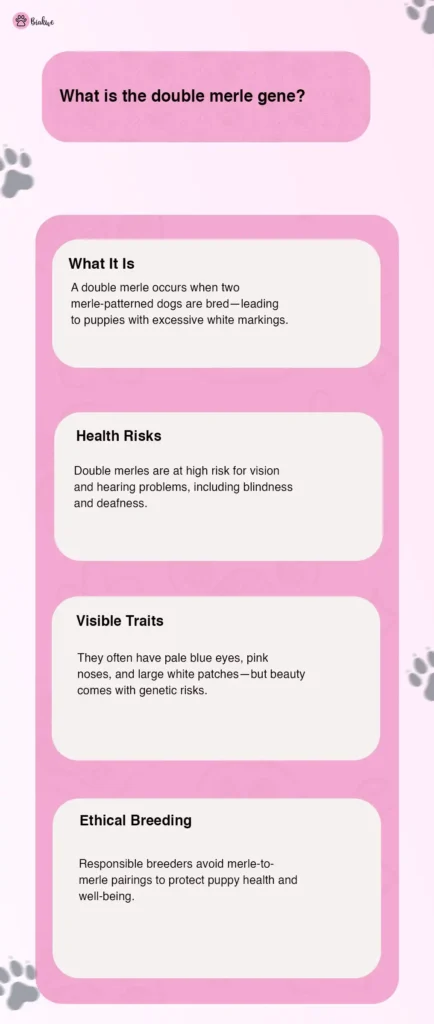The double Merle is described as a condition that occurs when two merle patterned dogs breed. Although the merle coat is very much admired due to its uniqueness and beautiful colour, it still results in a lot of health issues too. The most common example of double merle dog is the Australian Shepherd.

Double merle dog?
Merle is basically a genetic pattern that in dog’s pattern, that is responsible for the marbled coat in seen in various breeds like:
- Australian Shepard
- Border collies
- Shetland sheepdogs
- Dachshunds
- Great Danes
There’s a variety of merle colours seen and identified by different dog owners, but the most common ones are blue merles and red merles. A blue merle results in a mix of three different beautiful colours, that are grey, black and white patches.
What happens in Merle-Merle breeding?
The offspring that is produced due to cross between two merle dogs has a 25% of being a double merle dog, and inherits the merle gene twice. This produces a dog that appears white with either pale blue or marbled eyes, which is a characteristic of the double merle gene. In addition to changing the base coat, the merle gene also changes the color of the eyes, nose, and paw pads.
Regrettably, the merle-merle breed also results in certain severe birth abnormalities in its progeny.
Common Health issues in Double-Merles
Merle has health hazards in and of itself, particularly ”double merle” (having two copies of the gene). According to a paper published on November 24, 2024, the Merle gene increases the chance of hearing, blindness, eye abnormalities, skin cancer, congenital heart problems, and skeletal disorders. They frequently end up with developmental problems like these or are highly likely to experience hearing and vision impairments.
- Genetic Deafness (either one or both ears are deaf)
- Blindness (or even limited vision from either eye)
- Microphthalamia (the size of eye is abnormally small)
- Eye deformities (It could vary from underdeveloped retina to colobomas too)

In some cases, they might experience sensitivity in their ears that can further result in infections and inflammation too.
Life Expectancy of Double Merles
The life expectancy of the double merles is almost the same as of normal ones, despite having all the heredity issues. Their life expectancy is 12-15 years, which is equivalent to that of a normal one too. In some cases, they might experience a short life span, that too because of the impairments attached to their breed. Life expectancy depends on a lot of factors too, like the severity of their congenital conditions or the specific care they receive from their owner or the caretaker.
Though double merle dogs are prone to so many impairments of hearing and vision, still that does not actually reduce their life expectancy. The thing that does actually affect life span is how well these conditions are managed particularly in terms of safety, communication and stress reduction too, such as:
If a double-Merle Australian shepherd is deaf in both ears, his life span and impairment can be flourished by training him with hand signals, keeping him in a safe gated area.
Moreover, a blind Border Collie can be trained to navigate through the house, if the furniture and everything else is kept consistent.
The Double-Merle Australian Shepherd
This is the most common breed among the double-merled dogs. The reason why it is very common is because of its desired popularity among the owners of both dogs due to its blue merle coat.
Australian shepherds are offspring, the result of cross between either two blue merles, or either one blue and one red merle. These dogs are known for their beautiful white coat and piercing blue eyes, but with that comes a very high risk of hearing and vision impairment.
They appear to be mostly white with patchy or diluted merle markings on the body. Their eyes are either very bright blue or mismatched with vision impairment too. There’s always a risk of deafness among these dogs too due to inner ear nerve damage, usually caused by pigmentation.
One of the living examples of the challenged life of such dogs is a dog named “Keller”. Keller is an Austrian shepherd too, which is mostly white. Keller has inherited both merle genes from parents, which resulted in her being both deaf and blind. Keller was saved by this kind woman “Amanda Fuller” who saw her posts on Facebook and started her research on the condition of this dog.
She found out regarding the health risks that come with merle-merle cross. She helped Keller and despite her disabilities she still thrives to swim, hike, and competes with speed and obedience too. She also knows more than 15 hand and touch signals.
Responsible Breeding and Prevention
It is completely possible to avoid such breedings, keeping in mind the health risk caused by it.Though the mate produces a very beautiful breed yet the harm caused by it can not be avoided, there are various strategies that can be be used to avoid it such as:

- Avoiding Merle-merle pairings
- DNA Testing
- Educating dog owners and breeders
- Rescuing, providing rehabilitation and rescue inititaves
- Awareness raising initiatives
For more pet care tips, visit our site Biakwe
